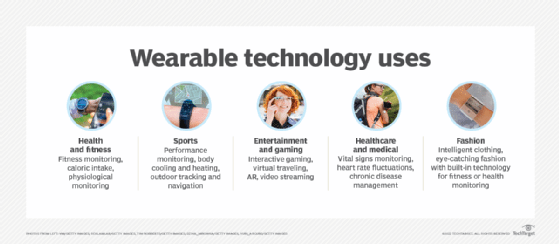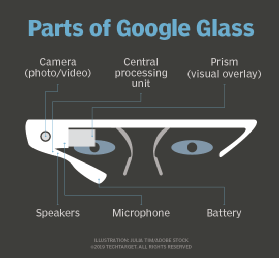What is Google Glass?
Google Glass was a wearable, voice and motion-controlled Android device that resembled a pair of eyeglasses and displayed information directly in the user's field of vision. It was discontinued in March 2023.
Google Glass offered an augmented reality (AR) experience by using visual, audio and location-based inputs to provide relevant information. For example, upon entering an airport, a user could automatically receive flight status information.
History of Google Glass
Google Glass was developed by Google's X subsidiary. It was intended to explore the possibilities of AR and wearable technology. It never reached the point of becoming a full consumer product.
The first version, dubbed Explorer Edition, was launched in 2013. Consumers immediately voiced their concern about the glasses being a potential invasion of privacy. To many, Google Glass represented inescapable recording in everyday life. Google attempted to rebrand the glasses as a tool for professionals such as surgeons or factory workers. However, concern remained, and Google ceased all work on the Glass Explorer project in 2015.
In 2017, work resumed with Glass Enterprise Edition. This relaunch of the project focused all efforts on making a product that would benefit workplaces like factories and warehouses. In 2019, a new version of Google Glass was released -- the Glass Enterprise Edition 2.
On March 15, 2023, Google ceased selling Google Glass. On Sept. 15, 2023, Google discontinued support for Google Glass.

Legacy of Google Glass
Google Glass was an early attempt at wearable technology. It was released before the first Apple Watch and Google Wear popularized smartwatches in the mainstream and they became the de facto standard wearable. As such, it entered at a time before the public was ready to accept an always-on and always-connected device. Especially with its prominent camera, many felt that it was recording them as well as concerns about its use during day-to-day interactions with others.
The refocusing of Google Glass on enterprise use cases injected added longevity into the project. It found some limited use in medical and industrial fields. It was especially useful in cases where the user needed to keep their hands free to accomplish another task.
Google Glass was the first attempt by a major technology company to bring an AR device to market. Other companies have since released AR devices, such as Microsoft HoloLens, Apple Vision Pro and Meta Quest, and while these have found some success, they have not reached the point of mass market acceptance. Still, some of the early innovations for Google Glass, such as always-on display, voice assistant, and displaying contextual information, have become integrated into smartphones and smartwatches.
How Google Glasses work
The Google Glass operating system (OS) was based on a version of Android. The OS could run application virtualization tools called Glassware that are optimized for the device. Glassware allowed the device to deliver an app to the user, instead of a full desktop. The glasses had built-in Wi-Fi and Bluetooth connectivity and a camera for taking photographs and videos.
The smart eyewear used motion and voice recognition to process commands from the wearer. A touchpad was also available on the glasses' rim. To provide the requested information, the device relied on sending small packages of information straight to the wearer through a micro-projector, using a private channel of communication that could only be accessed by the user.
Google Glass then used a field sequential color (FSC) liquid crystal on silicon (LCOS) system to display images on the lens, allowing wearers to view the image in true colors. FSC refers to a color television system that transmits the primary color information in continuous images and then relies on the human's vision and perception to collect the information into a color picture. LCOS is a form of video display technology.

Features of Google Glass
The key feature of Google Glass was the tiny semi-transparent screen located on the upper right-hand side of the glasses. This display occupied only about 5% of the wearer's natural field of vision and is responsible for transmitting information to the user.
In order to view the screen, wearers had to look up, placing the screen out of the direct line of vision. This feature is particularly important because bad placement of the display could lead to serious safety issues.
Other features of Google Glass included:
- The ability to take photos and videos and then share exactly what the user is seeing through Google Hangouts.
- The option to use the Google search engine through the glasses, using Wi-Fi or a smartphone's data connection.
- The ability to have translations streamed straight to the wearer through the screen.
- Reminders to complete certain chores or tasks with an added visual aspect that will prompt a notification to appear on the user's screen every time they look at a particular object.
- The ability to sync the glasses to calendars stored on phones or computers in order to receive reminders of events and meetings.
- Support of both voice and video calls. In the video calls, wearers can show the other person exactly what they're looking at instead of talking face-to-face.
- The ability to answer emails and text messages using voice dictation.
- Collaboration with Google Maps to provide step-by-step directions with a map displayed on the screen.
- The ability to respond to facial and head movements, such as allowing the user to tilt their head to scroll through a page or operate the device with eye movements.
Glass Enterprise Edition 2
The final version of Google Glass, Glass Enterprise Edition 2, features a USB-C port for faster charging, an improved camera and a processing boost from its new use of Qualcomm's Snapdragon XR1 chip, which is designed specifically for augmented and virtual reality systems. The XR1 chip allows the Google Glass device to integrate advanced machine learning and computer vision abilities.

Safety frames have been added to the design, making the glasses more effective and compatible in diverse work environments. Other improvements include a bigger battery that provides longer battery life, upgraded Wi-Fi and Bluetooth connections and support of Android Enterprise mobile device management.
Each wearable device comes with computing capabilities as well as several pros and cons. Learn about the benefits and management challenges posed by enterprise wearables.



